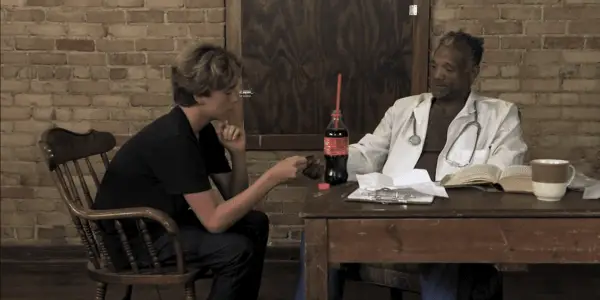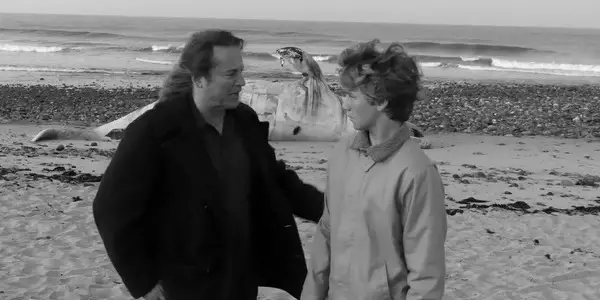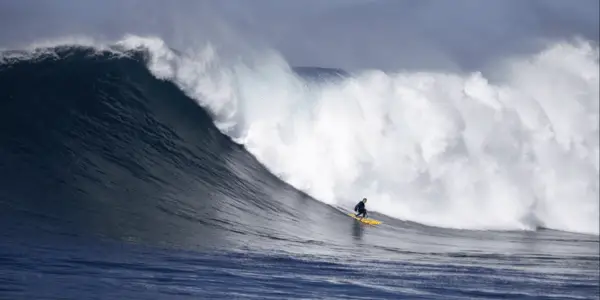SURFER: TEEN CONFRONTS FEAR: In Search of a Modern Cult Classic

Payton McCarty-Simas is a freelance writer and artist based in…
For aficionados of cult filmmaking, hunting for new and unusual movies to watch often takes on an obsessive quality. Since the days of like-minded friends exchanging VHS tapes of offbeat or micro-budget ephemera from outtakes of “the winnebago man,” to experimental student films like Apocalypse Pooh, to buried studio disasters like the Star Wars Holiday Special, this fanaticism often springs from a particular film’s obscurity. Yet, in an age when all of these previously coveted rarities can be readily watched on YouTube, it’s uncommon to stumble across a movie that’s virtually impossible to see. Enter: Surfer: Teen Confronts Fear. Since its first appearances at festivals and independent theaters in 2018, the film has garnered a familiar modern cult reception, largely based on gleeful incredulity and almost inevitable comparisons to The Room in outlets like Vice. At the same time, access remains elusive while the film screens sporadically around the country, roadshow-style, and a bona fide old school cult following has emerged: Reddit threads and Twitter accounts have sprung up to celebrate the film and share information about upcoming screenings; would-be fanatics report doing “annual searches” trying to find it online; those who have seen it in theaters extoll its virtues to those unfortunates who missed their chance. In these forums, watching this movie takes on the quality of a quest for the Holy Grail. To quote one Surfer fan, “the gospel must be spread.”

My personal crusade to see Surfer began in 2018 with this trailer for the film’s run at Spectacle, a collectively run theater in Brooklyn. Huge red banners flashed across the screen: “BELIEVE? From the sea… CAN PAST carve his future…” The eponymous surfer teen’s voice murmurs hypnotically: “One day I rode one of the biggest waves I’d ever ridden at the time… I never knew… there was such a fear.” Flutes play in the background. A man vomits black ooze. A freeze frame of a man ducking behind a battered Volvo promises MILITARY INTRIGUE. I was hooked. I had to see Surfer: Teen Confronts Fear. Alas, though, I was too late to catch it. Thus began my six-year journey to see the film… culminating in this article. To finally do so, and to finally understand what makes the film so compelling, I contacted the creators of Surfer as well as the stalwart programmers who shepherded the film into micro-stardom. Soon, I received a screener.
Fathers and Sons and Squids and Electricity
Surfer: Teen Confronts Fear is a dyed-in-the-wool midnight movie experience–– and as all good midnight movies do, it eludes comparison. It isn’t really The Room (nothing is). It’s not Birdemic: Shock and Terror, or Endless Summer either, though it has shades of all of them. It also evokes the works of Neil Breen and Ed Wood, replete with idiosyncratic performances, unorthodox plotting (in both senses of the word), a deep sense of personal style and ideology, and strategically placed pre-existing footage. Directed by Douglas Burke, a retired physicist, and professor, the film follows Sage (played by Sage Burke, Doug‘s real-life son), a young surfer who recently wiped out and fears getting back in the water. Doug plays his father, who was killed in “the war” (what war isn’t specified) but whose astral body returns to Sage in a rapidly deteriorating human form made of “squids and electricity” given to him by God for a couple of hours, like Cinderella’s dancing shoes. From there, Doug gives Sage a metaphysical pep talk–– part guided meditation, part Bible studies class–– delivered in tones that range from a dulcet whisper to a hoarse bellow and shot over the course of nine years. The scene features, among other things, a sermon delivered beside the carcass of a real whale that washed ashore at some point during filming. Some of Doug‘s lines are all-time greats, from his dismayed bellow that he’s “LIVING IN AN IRON MAIDEN OF PAIN!” to his insistence that Sage’s “cells are vibrating like little babes in the woods and they’re frightened.” Sage’s age fluctuates wildly, sometimes from shot to shot. The languorous pacing and liberal use of surfing footage here verges on slow cinema or a Bela Tarr film–– this opening scene is 48 minutes long (the film’s total runtime is 101 minutes) and takes place largely in a single beachside grotto. As the poster extolls, this scene in particular “must be seen to be believed.”

From there, Doug delivers a prophecy, instructing Sage to seek out his old army buddy before returning his molluscan body to the sea. The boy goes on a quest to discover his father’s past, meeting army doctors, old sea captains, and a rogue’s gallery of criminals along the way–– one of whom tells him (unprompted) that “if you’re the good guy, it’s good to kill.” Green screens and community theaters abound (his cast is drawn from his local acting troupe). One scene with the doctor, in particular, is a standout, featuring a glorious continuity error involving a soda can (“get this man a coke!”) that brought me to hysterics. Eventually, Sage, too, returns to the sea for a 25-minute surfing odyssey composed of globetrotting GoPro vacation footage so expressionistic it could be accurately described as a zenned-out, gonzo version of Godard‘s The Image Book. To quote Doug‘s character, watching Surfer Teen is like “riding a very large wave… a very large wave of INSANITY!”
“A Little Bit of Madness”
“I’m in awe that you’ve been in search of this film, but also not TOTALLY surprised either,” Erin Lempkey, a former programmer at Spectacle, told me in an email. “I remember during the original (pre)screening of the film, moments where we were absolutely melting, like the long Biblical monologue that involves some kind of vomit/expectorant from Burke… [and] there was a LOT of wave b-roll. This created the effect of having spent the day in the water and being very washed out.” Lempkey also described the experience of the film as a combination of “laughing [and] having out-of-body experiences,” a fitting combination for any good midnight movie. The film played at Spectacle eight times over two months in 2018, exceeding the average run for screenings at the theater, which specializes in repertory and cult film, after high turnout. When asked what makes the film so appealing, Lempkey cited its “psychotic-level earnestness that is at moments totally gripping.”

Barney Oldfield, an Anthology Film Archives board member and producer of the NewFilmmakers Festival, (which featured the film in 2018,) told me Surfer had similarly “incredibly successful” runs in Los Angeles, where it sold out at one theater for a week straight. Like Spectacle, NewFilmmakers focuses on what Oldfield called “some really bizarre movies.” For example, “We’ve shown pornography, a whole evening of dog movies, biker movies, anything that’s different,” he said. When I asked what he thinks makes Burke‘s film so compelling to audiences, his response echoed Lempkey‘s: “It is him. [The film’s] not a put on… you can’t go out and make a midnight movie… you have to believe in something so outlandish that it works.” “Most films,” he continued, “are very dishonest. People respond to honesty.” Surfer, on the other hand, is 100% Burke‘s film. “It’s his personal vision,” Oldfield stressed, “and that’s what independent film is about.” For Oldfield, this combination of individual artistic expression and eccentricity is what drives filmmaking forward for everyone: “[Jonas Mekas] didn’t have any idea what he was doing when he started out, his vision was completely out there from the Hollywood world. Yet everything he did has been incorporated into what you see today” he said, noting MTV’s liberal use of Mekas‘ signature jump cuts. “You either get it or you don’t get it, and that’s [Burke‘s movie] too. There will always be people out there who for some reason, maybe even mental illness, they get it.”

When I finally spoke to Doug Burke over Zoom, he told me he wasn’t sure what made the film so appealing to those who hadn’t seen it yet. When articles first came out describing Surfer as a cult film, his initial reaction was defensive. He even pointed me to an interview he gave defending his film from a critic by accusing him of having a “bad relationship with his own father” on psychoanalytic grounds. He takes his project seriously and draws inspiration from directors like David Lean and Orson Welles and actors like Peter O’Toole and Richard Burton. More recently, though, Burke says he’s come to terms with the label “midnight movie”: “I like it. Tarantino‘s films are like that.” Plus, cult films have more room to experiment and engage with their audiences in unique ways–– “I like the midnight movie thing because what happens after a midnight movie can be off the wall. The audience is enthusiastic and as honest as the day is long about what they feel and see and like. They’re respectful in their honesty about how they’re feeling.” As for his previous reaction to the ways audiences find humor in the film, “we tried to do that, but we didn’t know how successful it would be. We didn’t know why people would laugh.” Still, he said, “if you study it, it really is a divine comedy.”
“People laugh for lots of reasons,” Burke mused, “sometimes they laugh uncontrollably when they’re uncomfortable. There’s the poetic catharsis that comes from that, and I respect [audiences laughing at the film] because there are things they don’t understand. It’s like the reaction to a dead body: the first response is to laugh because you don’t understand. It’s pretty serious psychology.”

When I asked him about his first experience watching a film with an audience, he told me that “The second time I saw it, the theater was full and when my character goes back to the ocean, everyone screamed and applauded. And I thought, ‘That was great, they laughed where I thought my character was funny.’ There’s a little bit of madness to the character and that can create another kind of humor. If you study madness,” he grinned, inadvertently echoing Oldfield‘s comments on cult audiences, “some people relate to it by laughing because they have parts of themselves that are like that or would like to be like that and that can create real gut laughter. You couldn’t do a standup routine and get that same kind of laughter.” But, he reminded me, people are still genuinely excited about his film outside of its humor alone: “People understand you. If you’re excited, then they get excited.”
Conclusion:
A midnight movie, Oldfield told me, “Is like crabgrass. You can’t grow crabgrass. It has to exist in an ecology of other grasses, you can’t grow it on your own–– it doesn’t work.” For Doug Burke, this unique alchemy has created something that packed audiences of all stripes can enjoy, coming together organically to find something obscure on their own out of a passion for unique, genuinely weird filmmaking. When I asked him why Surfer still isn’t available to rent online, he said it wasn’t time: “I like it as a roadshow for now, and eventually when it does come out for rent the roadshow marketing will have spread itself far enough… but we’re not quite there yet.” Surfer continues to make its way around the world, screening at independent theaters from Milwaukee to Helsinki, and it’s worth the wait. If it screens again in New York, all of my friends and I will be there. Ultimately, the film’s dedication and earnestness and Burke‘s personal love of film do speak to the things that make independent filmmaking special for directors as well as audiences–– there’s a fine line between Tarantino‘s references to Fellini and Wiseau‘s references to Welles. Surfer: Teen Confronts Fear is both unique in the canon of midnight movies and reaffirms what makes each of them wonderful and strangely invigorating for even seasoned film buffs to watch. Originally, Burke intended Surfer to be a silent film in black and white, “kind of like Mickey Mouse growing up conquering the larger waves.” But he feels that the film’s message of love and family and “the innocence of the child conquering the fear,” comes across in the final version: “Film is a waking dream,” he told me, “and anything is possible in the dream.”
Watch Surfer: Teen Confronts Fear
Does content like this matter to you?
Become a Member and support film journalism. Unlock access to all of Film Inquiry`s great articles. Join a community of like-minded readers who are passionate about cinema - get access to our private members Network, give back to independent filmmakers, and more.
Payton McCarty-Simas is a freelance writer and artist based in New York City. They grew up in Massachusetts devouring Stephen King novels, Edgar Allan Poe stories, and Scooby Doo on VHS. Payton holds a masters degree in film and media studies from Columbia University and her work focuses on horror film, psychedelia, and the occult in particular. Their first book, One Step Short of Crazy: National Treasure and the Landscape of American Conspiracy Culture, is due for release in November.













